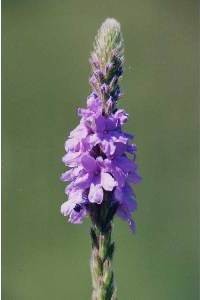Seashore vervain
(Verbena litoralis)

Description
Verbena litoralis is a species of verbena known by the common names seashore vervain and Brazilian vervain, and in Hawaiian, ōwī. It is native to the Americas from Mexico south through Central and South America to Argentina and Chile. It is present throughout the world as an introduced species and in some areas a noxious weed. It is naturalized in the contiguous United States, Puerto Rico, Hawaii, Italy, Spain, South Africa, Mauritius, the Galápagos Islands, Australia, Easter Island, French Polynesia, Japan, New Zealand, and other places. It grows in many types of habitat, including disturbed and cultivated areas. This perennial herb produces one or more hairless or slightly bristly erect stems growing 40 centimeters to well over one meter tall. The rough-haired leaves are somewhat lance-shaped and have serrated edges, the blades measuring up to 10 centimeters in length. The inflorescence is made up of one to eleven erect spikes of flowers which are dense at the tip and more open on the lower part. Each small tubular flower has a purple corolla about half a centimeter wide. Verbena, also known as vervain or verveine, is a genus in the family Verbenaceae. It contains about 150 species of annual and perennial herbaceous or semi-woody flowering plants. The majority of the species are native to the Americas and Asia; however, Verbena officinalis, the common vervain or common verbena, is the type species, and native to Europe. Verbena is an herbaceous flowering plant, belonging to the Verbenaceae family, and may be annual or perennial depending on the species. The leaves are usually opposite, simple, and in many species hairy, often densely so. The flowers are small, with five petals, and borne in dense spikes. Typically some shade of blue, they may also be white, pink, or purple, especially in cultivars. The genus can be divided into a diploid North American and a polyploid South American lineage, both with a base chromosome number of seven. The European species is derived from the North American lineage. It seems that verbena as well as the related mock vervains (Glandularia) evolved from the assemblage provisionally treated under the genus name Junellia; both other genera were usually included in the Verbenaceae until the 1990s.
Taxonomic tree:







